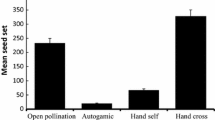Summary
We examined net seed production for the self-incompatible, monocarp, Ipomopsis aggregata, by monitoring pre-pollination seed parasite (Hylemya sp.) oviposition and hummingbird mediated fruit set on 21 plants of variable height. Both pollination and seed predation increased with inflorescence height. Net seed production (incorporating seed predator mortality) also was positively related to height, and this would have been the case if pollination or seed predation were doubled. Although results suggest pomopsis aggregata should be under selective pressure to maximize inflorescence height, generation time and resource limits could result in advantages for inflorescences of intermediate height.
Similar content being viewed by others
References
Augspurger CK (1981) Reproductive synchrony of a tropical shrub: experimental studies on effects of pollinators and seed predators on Hybanthus prunifolius (Violaceae). Ecology 62:775–788
Casper BB, Wiens D (1981) Fixed rates of random ovule abortion in Cryptantha flava (Boraginaceae) and its possible relation to seed dispersal. Ecology 62:866–869
DeSteven D (1983) Reproductive consequences of insect seed predation in Hamamelis virginiana. Ecology 64:89–98
Green TW, Palmbald IG (1975) Effects of insect seed predators on Astragalus cibarius and Astragalus utahensis (Leguminosae). Ecology 56:1435–1440
Haddock RC, Chaplin SJ (1982) Pollination and seed production in two phenologically divergent prairie legumes (Baptisia leucophaea and B. leucantha). Am Midl Natur 108:175–186
Hainsworth FR, Mercier T, Wolf LL (1983) Floral arrangements and hummingbird feeding. Oecologia (Berl) 58:225–229
Harper JL (1977) Population biology of plants. Academic Press, London, England
Heithaus ER, Stashko e, Anderson PK (1982) Cumulative effects of plant-animal interactions on seed production by Bauhinia ungulata, a neotropical legume. Ecology 63:1294–1302
Hubbell SP (1980) Seed predation and the coexistence of tree species in tropical forests. Oikos 35:214–229
Inouye DW, Taylor OR Jr (1980) Variation in generation time in Frasera speciosa (Gentianaceae), a long-lived perennial monocarp. Oecologia (Berl) 47:171–174
Janzen DH (1969) Seed-eaters versus seed size, number, toxicity and dispersal. Evolution 23:1–27
Louda SM (1982) Inflorescence spiders: a cost/benefit analysis for the host plant, Haplopappus venetus Blake (Asteraceae). Oecologia (Berl) 55:185–191
Meijden E van der, Waals-Kooi RE van der (1979) The population ecology of Senecio jacobaea in a sand dune system. J Ecol 67:131–153
Moore LR (1978a) Seed predation in the legume Crotalaria I Intensity and variability of seed predation in native and introduced populations of C. pallida Ait. Oecologia (Berl) 34:185–202
Moore LR (1978b) Seed predation in the legume Crotalaria II Correlates of interplant variability in predation intensity.Oecologia (Berl) 34:203–223
Schaal BA (1980) Reproductive capacity and seed size in Lupinus texensis. Am J Bot 67:703–709
Schaffer WM, Schaffer MV (1979) The adaptive significance of variations in reproductive habit in the Agavaceae II: Pollinator foraging behavior and selection for increased reproductive expenditure. Ecology 60:1051–1069
Schmitt J (1980) Pollinator foraging behavior and gene dispersal in Senecio (Compositae). Evolution 34:934–943
Stephenson AG (1981) Flower and fruit abortion: proximate causes and ultimate functions. Ann Rev Ecol Syst 12:253–280
Waser NM (1978) Competition for hummingbird pollination and sequential flowering in two Colorado wildflowers. Ecology 59:934–944
Waser NM (1982) A comparison of distances flown by different visitors to flowers of the same species. Oecologia (Berl) 55:251–257
Waser NM, Real LA (1979) Effective mutualism between sequentially flowering plant species. Nature 281:670–672
Weis IM (1982) The effects of propagule size on germination and seedling growth in Mirabilis hirsuta. Can J Bot 60:1868–1874
Willson MF, Price PW (1977) The evolution of inflorescence size in Asclepias (Asclepiadaceae). Evolution 31:495–511
Willson MF, Rathke BJ (1974) Adaptive design of the floral display in Asclepias syriaca L. Am Midl Natur 92:47–57
Zimmerman M (1980a) Reproduction in Polemonium: competitions for pollinators. Ecology 61:497–501
Zimmerman M (1980b) Reproduction in Polemonium: pre-dispersal seed predation. Ecology 61:502–506
Author information
Authors and Affiliations
Rights and permissions
About this article
Cite this article
Reed Hainsworth, F., Wolf, L.L. & Mercier, T. Pollination and pre-dispersal seed predation: net effects on reproduction and inflorescence characteristics in Ipomopsis aggregata . Oecologia 63, 405–409 (1984). https://doi.org/10.1007/BF00390673
Received:
Issue Date:
DOI: https://doi.org/10.1007/BF00390673




